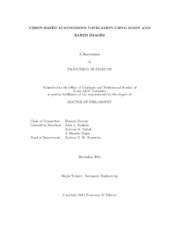| dc.description.abstract | This document explores the possibility of a novel approach to trajectory determination based on optical observation of nearby celestial bodies, and describes its development, implementation and testing. The initial idea was spurred by the need to give the Orion capsule, the next-generation manned spacecraft currently in development at NASA, a backup autonomous positioning system. Among other missions, Orion is designed to transport a crew to and from the Moon. The presence of individuals on board tightens the safety requirements, and therefore it is necessary to provide a backup positioning system in case contact with ground is lost. However, rather that develop and install specific hardware on the craft, this work attempts to use data form a pre-existing sensor, an optic camera, for position estimation. This research consists of three main sections: first, analysis of the images captured by camera, to identify the geometrical features of interest of the observed celestial bodies (namely apparent radius, center position and orientation). Second, estimate of these properties with various best fitting algorithms, and derivation of orientation and position of the spacecraft in an inertial frame. And last, best fitting of the gathered position data with a newly developed algorithm based on Bézier functions. Each of these parts are discussed in detail. Results show that the image processing algorithm developed is capable to meet the accuracy requirements imposed by the mission, and that Bézier functions are a suitable tool to efficiently interpolate space trajectories, favorably comparing to more complex techniques like Iterative Batch Least Square and Extended Kalman Filter. | en |


